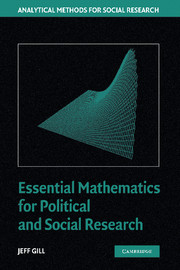Book contents
- Frontmatter
- Contents
- List of Tables
- List of Illustrations
- List of Examples
- Preface
- 1 The Basics
- 2 Analytic Geometry
- 3 Linear Algebra: Vectors, Matrices, and Operations
- 4 Linear Algebra Continued: Matrix Structure
- 5 Elementary Scalar Calculus
- 6 Additional Topics in Scalar and Vector Calculus
- 7 Probability Theory
- 8 Random Variables
- 9 Markov Chains
- References
- Author Index
- Subject Index
2 - Analytic Geometry
Published online by Cambridge University Press: 05 June 2012
- Frontmatter
- Contents
- List of Tables
- List of Illustrations
- List of Examples
- Preface
- 1 The Basics
- 2 Analytic Geometry
- 3 Linear Algebra: Vectors, Matrices, and Operations
- 4 Linear Algebra Continued: Matrix Structure
- 5 Elementary Scalar Calculus
- 6 Additional Topics in Scalar and Vector Calculus
- 7 Probability Theory
- 8 Random Variables
- 9 Markov Chains
- References
- Author Index
- Subject Index
Summary
Objectives (the Width of a Circle)
This chapter introduces the basic principles of analytic geometry and trigonometry specifically. These subjects come up in social science research in seemingly surprising ways. Even if one is not studying some spatial phenomenon, such functions and rules can still be relevant. We will also expand beyond Cartesian coordinates and look at polar coordinate systems. At the end of the day, understanding trigonometric functions comes down to understanding their basis in triangles.
Radian Measurement and Polar Coordinates
So far we have only used Cartesian coordinates when discussing coordinate systems. There is a second system that can be employed when it is convenient to think in terms of a movement around a circle. Radian measurement treats the angular distance around the center of a circle (also called the pole or origin for obvious reasons) in the counterclockwise direction as a proportion of 2π.
Most people are comfortable with another measure of angles, degrees, which are measured from 0 to 360. However, this systemis arbitrary (although ancient) whereas radian measurement is based on the formula for the circumference of a circle: c = 2πr, where r is the radius. If we assume a unit radius (r = 1), then the linkage is obvious. That is, from a starting point, moving 2π around the circle (a complete revolution) returns us to the radial point where we began. So 2π is equal to 360° in this context (more specifically for the unit circle described below).
- Type
- Chapter
- Information
- Essential Mathematics for Political and Social Research , pp. 51 - 81Publisher: Cambridge University PressPrint publication year: 2006

